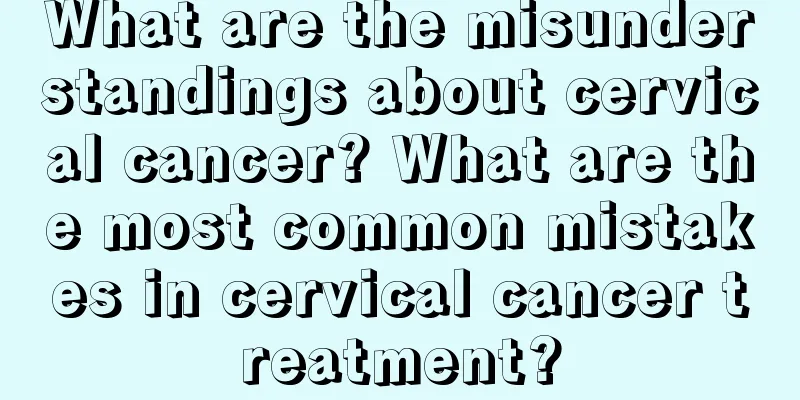What are the misunderstandings about cervical cancer? What are the most common mistakes in cervical cancer treatment?

|
Cervical cancer vaccination and pasteurized smear tests enable humans to detect and treat cancer at an early stage. However, experts remind that female friends still have many misunderstandings about cervical cancer, which seriously affects the cure rate of patients. Myth 1: Cervical cancer cannot be prevented. Anthony Opipari, associate professor of obstetrics and gynecology at the University of Michigan Medical School, believes that people's behavioral habits, such as multiple sexual partners, smoking and other bad habits, will significantly increase the risk of cancer, so changing these lifestyle conditions and regular physical examinations can reduce the incidence rate. In particular, the cervical cancer vaccine, which was launched in 2006, has made a great contribution to preventing the occurrence of cancer. On January 23, the American Cancer Society issued a new guideline recommending that women over the age of 9 be vaccinated against cervical cancer. On the same day, the British government also announced that women over the age of 12 will be included in the vaccination plan. Myth 2: Since the vaccine can prevent cervical cancer, you will not get cancer even if you do not use a condom after vaccination. Explanation: Currently, the cervical cancer vaccine can only prevent four types of human papillomavirus, but for other causes of cervical cancer, the new vaccine is still useless. Continuing to use condoms can reduce more cervical cancer. Myth 3: I am still young, so I don’t need to worry about cervical cancer and don’t need to get checked at all. Explanation: In recent years, the age of cervical cancer has become younger and younger. Therefore, women should undergo their first Pap test at the age of 21 or after 3 years of sexual intercourse, and consult their doctor about how long to do it. Even if you have been vaccinated, you still need to do a Pap test. In fact, age doesn't mean anything; even if you've reached menopause, had a hysterectomy, or are over 65, a Pap smear test is still necessary. Myth 4: A gynecological examination is a Pap smear test, and a positive result is definitely cancer. Explanation: A Pap test collects cells from the cervix and sends them to a lab for measurement; a gynecological exam is a physical examination of the cervix and other appendages by the doctor, which is different. However, they are very important for early diagnosis. In addition, if the Pap smear test result is positive, it is not necessarily cancer, and further examinations such as papillomavirus test, colposcopy or cancer cell biopsy are needed to confirm the diagnosis. On the contrary, if there are problems such as bleeding and pain, further treatment should be carried out even if the Pap smear test result is normal. Myth 5: Cervical cancer has no symptoms and one can only wait for death after diagnosis. Explanation: Bleeding after sexual intercourse and intermittent menstrual bleeding are signs of cervical cancer, as are other abnormal discharges or local pelvic pain. The survival rate of patients with early cervical cancer is relatively high. In addition, cervical cancer recurrence mainly occurs within 2 years after treatment, and once it is 5 years, the risk of recurrence is very low. Myth 6: Cervical cancer must be removed, but you will not be able to have children after the operation and menopause will come early. Explanation: Hysterectomy is the conventional treatment for early cervical cancer, but it is not the only option. Conization and radical trachelectomy can avoid hysterectomy, and women can retain their right to motherhood as much as possible without affecting their survival. Of course, after a hysterectomy, since the ovaries are not removed to determine the physiological characteristics of women, early menopause is not common and patients do not have to worry too much. |
<<: How to treat cervical cancer? Six common misunderstandings about cervical cancer treatment
>>: What are the treatments for cervical cancer? How to treat cervical cancer
Recommend
The order of isolation, sunscreen and foundation
Isolation and sunscreen foundation are relatively...
What causes a rash after getting a leprosy vaccine?
Many babies will experience various discomfort sy...
How to raise your hair
Many women like to comb their hair higher to matc...
What material is best for removable dentures
In our lives, there are always some friends aroun...
What kind of painkillers are suitable for patients with advanced bone cancer to take for a long time
When it comes to cancer, everyone is very scared....
What is the significance of cancer screening?
As we all know, there are many tumors in the huma...
What medicine is good for deficiency of qi and blood, kidney deficiency and spleen deficiency
A person cannot live without money, but cannot li...
What are the symptoms and manifestations of skin cancer
Since many patients do not know enough about skin...
How is kidney stones treated with TCM?
Kidney stones are a common urinary system disease...
Should I wake my sleeping baby up to feed him?
When it comes to feeding babies, different people...
What are the treatments for primary liver cancer
Primary liver cancer refers to cancer that origin...
Girls have broad shoulders, how to shrink their shoulders
In real life, it is a common problem for many peo...
Diagnosis of small cell lung cancer
Small cell lung cancer is a common cancer. Now mo...
What is the reason for numbness in legs when meditating
With the development of society, people's liv...
Is it good to wash your face with mineral water? You need to know these
With the rapid development of the economy, people...









